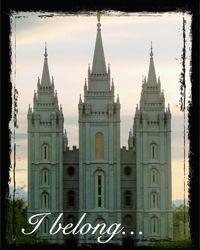Q: What Israelite book of scripture, mentioned twice in the O.T., was quoted by Joseph Smith, but is not in the King James Bible?
A: The Book of Jasher. The Book of Jasher is mentioned in Joshua 10:13 and 2 Samuel 1:18. It is a history of the world from the creation until the period of the Judges in Israel. It has more information than is found in Genesis for that same period, which makes very interesting reading and clears up many confusing issues in the Bible. The Church does not have an official stand on its authenticity, but most likely it was a 12th-century compilation of old Jewish writings that may have been preserved on Noah’s ark, and handed down to other ancient patriarchs.
OT lesson 2: This question reinforces the name of Jehovah and that Jehovah is the God of the Old Testament.
Q: What is a Tetragrammaton? a. a tropical fish b. a four-letter word c. a translation aid d. Greek form of “holy war”
A: The word literally means “4 letters”. The particular four consonant letters used in ancient Hebrew to signify the sacred name of God which they did not utter. The four consonants are variously written IHVH, JHVH, JHWH, YHVH and YHWH and the words reconstructed by adding vowel points are variously supposed to be Jahaveh, Jahvah, Jahve, Jahveh, Yahve, Yahveh, Yahwe, and Yahweh. The name Jehovah is thought by scholars to be a false reconstruction of the incommunicable name. From latter-day revelation, however, we learn that Jehovah is the English form of the actual name by which the Lord Jesus was known anciently.
OT lesson 3:
Q: What is Adam-ondi-Ahman interpreted to mean?
A: Orson Pratt suggested that “Ahman” is the name of God in the pure Adamic language. Ahman is twice mentioned as one of the names of God in the Doctrine and Covenants. In each instance, Jesus Christ is called Son Ahman, suggesting Son God and son of Ahman (D&C 78:20; 95:17). Elder Alvin R. Dyer expanded on that information as he defined Adam-ondi-Ahman: “Adam” refers directly to Adam; “ondi” means nearby or connected with; “Ahman” means the Lord himself. Therefore a literal translation of the words “Adam-ondi-Ahman” could signify “The Lord Jesus Christ, through Adam unto mankind”. It has also been interpreted to mean several things: the Valley of God where Adam dwelt, Adam's consecrated Land, and Adam's grave.
OT lesson 4: This trivia question doesn't have anything to do with the OT, but it iss interesting nonetheless:
Q: Two of our Church Presidents have had warships named after them. Can you name these two Church Presidents?
A: The "SS Joseph Smith" (hull number 1119) and the "SS Brigham Young" (hull number 633) were both Liberty cargo ships, the largest class of civilian-made warships ever built. These Liberty-class ships were the workhorses of World War II, as they could carry almost 5,000 tons of cargo. The "SS Joseph Smith" was launched in June of 1943 and it eventually sank due to cracks that developed in the hull. The "SS Brigham Young" was launched in September of 1942 and served in the Pacific theater. It was decommissioned at Pearl Harbor in 1946 and then towed to San Francisco. In 1973 it was sold to California buyers for scrap metal.
OT lesson 5:
Q: What do the names “Cain” and “Abel” mean?
A: Meaning of the name Cain: Its Hebrew root means to "possess" or "acquire." The name Cain is confusing to us as it does to Bible scholars because so little is said about Cain in Genesis. Latter-day scriptures give us more insight into Cain and why his parents gave him the name Cain. Such was the hope of Eve in her new heaven-sent "possession," and hence the name Cain.
Abel's name is associated with a root meaning “vanity,” “breath,” or “vapor.” Figuratively it seems to carry the connotation of “temporary” or “transitory”, which is appropriate since he would be murdered by Cain.
OT lesson 6:
Q: How big was Noah’s Ark?
A: 300 cubits = 450 feet long, by 50 cubits = 75 feet wide, by 30 cubits = 45 feet high – so the ark was 50% longer than a football field and 3 stories tall. [from Genesis 6:14-16 Make thee an ark of gopher wood; rooms shalt thou make in the ark, and shalt pitch it within and without with pitch. 15 And this is the fashion which thou shalt make it of: The length of the ark shall be three hundred cubits, the breadth of it fifty cubits, and the height of it thirty cubits. 16 A window shalt thou make to the ark, and in a cubit shalt thou finish it above; and the door of the ark shalt thou set in the side thereof; with lower, second, and third stories shalt thou make it.]
Gopher wood: Scholars have speculated that it was a species of cypress or cedar.
Pitch: asphalt or bitumen in its soft state, called slime
Window: see footnote in the LDS edition of the Bible and we learn that some rabbis believe that the “window”, translated from the Hebrew word “tsohar”, was actually a precious stone that shone in the ark.
OT lesson 7: Although this question was about a Book of Mormon individual, I used it to introduce the purpose of patriarchal blessings and a definition of lineage.
Q: What was Lehi’s lineage?
A: Tribe of Joseph, through Manasseh. [See Alma 10: 2-3 I am Amulek; I am the son of Giddonah, who was the son of Ishmael, who was a descendant of Aminadi... And Aminadi was a descendant of Nephi, who was the son of Lehi, who came out of the land of Jerusalem, who was a descendant of Manasseh, who was the son of Joseph who was sold into Egypt by the hands of his brethren.] However, Ishmael was of the lineage of Ephraim, bringing Ephraimite lineage to the promised land.
OT lesson 8: I used this question to introduce the concept of a “new name” when we make covenants, which happened when Abram and Sarai were renamed Abraham and Sarah.
Q: Who was the Zionist visionary that promoted the modern-day gathering of Jews to Israel and became the first prime minister of Israel in 1948?
A: David Ben-Gurion
Hebrew names typically include mention of the parents’ Hebrew name. Therefore, the name David Ben-Gurion actually means “David, son of Gurion”. Other examples include Simon Peter (referred to usually just as Peter) when the Savior called him Simon Bar-Jonah which means “Simon, son of Jonah”. Many have probably seen the movie Ben-Hur; the lead character, Judah Ben-Hur means “Judah, son of Hur”. When someone coverts to Judaism, the convert chooses a new Hebrew first name. For men it is usually Abraham or Avraham and for women it is often Sarah or Ruth. Since the convert has no Jewish parents, it is common to add “ben Avraham”, or son of Abraham. For women the addition is “bat Sarah”, daughter of Sarah.
Both in the O.T. and today, a new name is often involved when we make covenants with God.
- When we are baptized, we take upon ourselves the name of Christ.
- Temple follow the same pattern.
- Upon entering mortality, infants are given a new (earthly) name and blessing (although not a saving ordinance like baptism, because we know that little children have no need of baptism until they are eight years old).
- The Doctrine & Covenants tells us that “Those who come into the celestial kingdom” shall be given a white stone whereon is written a new name.
Genesis 17:1, 5, 15 AND when Abram was ninety years old and nine, the LORD appeared to Abram, and said unto him, I am the Almighty God; walk before me, and be thou perfect. 5 Neither shall thy name any more be called Abram, but thy name shall be Abraham; for a father of many nations have I made thee. 15 And God said unto Abraham, As for Sarai thy wife, thou shalt not call her name Sarai, but Sarah shall her name be.
When their names were changed, they then had the Hebrew letter “heh”, one of the abbreviations for the Hebrew name of God which Jews were never to write in its entirety. Hebrew letters each have a lot of symbolism associated with them. This letter connotes to “take seed” and to “behold or receive revelation”.
OT lesson 9:
Q: Which OT event came as the result in part from the discovery of new building technology (“oven-baked bricks”)?
A: The tower of Babel; before the bricks were all adobe, or sun-dried, and they crumbled under stress.
OT lesson 10:
Q: How long can camels go without water? If a camel is thirsty, how much water does it need to rehydrate itself?
A: During the hottest part of the year, a camel can go for a week or more without taking a drink. And during the cooler months, they sometimes go for six months without drinking. Even when water is available at wells and water holes, camels drink only if necessary. If they have used up a lot, they can gulp down as much as 30 gallons of water in just 10 minutes.
What other ways is a camel perfect for desert life?
- To protect their eyes, camels have long eyelashes. If sand gets into an eye, a camel has a third eyelid that moves from side to side to wipe the sand away. The eyelid is very thin, so a camel can close its third eyelid during sandstorms and still see.
- To keep sand from blowing into their noses, camels can shut their nostrils.
- Their short coats help to block out the heat of the sun.
- A camel's head has built-in sun-visors to help keep the bright sunlight out of its eyes. There are broad ridges of bone above each eye. These stick out far enough to shield the eyes when the sun is overhead. The ears of camels are small to make it harder for sand to get in them.
- The huge feet of camels help them to walk on sand without sinking into it. A camel's foot can be as big as a large plate.
- Camels humps help them to survive in the desert. The humps are masses of fat that nourishes them when food is scarce. They store about 80 pounds of fat in their humps. As the camels use this fat, their humps shrink.



